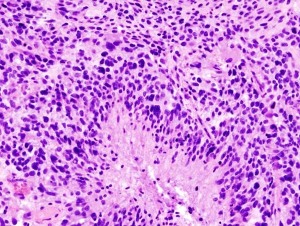Nanobio Therapy Deadly to Brain Cancer
by
Brendon Nafziger, DOTmed News Associate Editor | September 16, 2009

Glioblastoma multiforme,
shown in a histological sample,
is one of the deadliest
forms of brain cancer
Scientists at the Argonne National Laboratory and the University of Chicago working with nanobio interfaces -- interactions between nano-sized particles and biological substances -- have developed a cutting-edge technique to kill a rare and deadly form of brain cancer, according to a study published in the Sept. 9 issue of Nano Letters.
The technique works by pairing up nanoscale cancer-fighting material with a biological delivery mechanism, and spares healthy tissue while bringing destruction to glioblastoma multiforme (GME) tumors. GME is a malignant breed of brain cancer that often means death within a year of diagnosis and annually kills around 13,000 Americans. Some experts believe GME caused the malignant glioma that felled Sen. Edward Kennedy last month.
The therapy involves tethering particles of titanium dioxide -- only 5 nanometers in length, or about the size of a single protein molecule -- to an antibody naturally programmed to seek out GME cells.
But this nanobio hybrid does nothing in darkness. To fight cancer, it needs exposure to light. Titanium dioxide, a generally harmless material found in sunscreens and other products, undergoes a useful physical change when illuminated.
"The energy from light produces an excited state in titanium dioxide," Dr. Elena Rozhkova, lead author of the study and a researcher at Argonne National Laboratory, a federally run lab in Argonne, IL, tells DOTmed News. "It is eager to transfer this excess of energy," she says, which it does to passing oxygen molecules, causing free oxygen radicals to form.
These free radicals can then burrow deep inside the cancer cell where they kill it by giving it biochemical instructions asking it to commit suicide. "We tell the cell: it's time to die," says Dr. Rozhkova.
In the experiment using cell cultures, after five minutes of exposure to light 86 percent of the cancer cells were dead within 48 hours. And because the antibody only delivers the titanium dioxide to the targeted cancer cell, healthy tissue is completely unaffected. "There was no toxicity" to healthy brain cells surrounding the cancer in the culture, Dr. Rozhkova says.
Dr. Rozhkova notes that the technique would not replace surgery. The skull would still have to be opened to admit light for the titanium dioxide to work, although Dr. Rozhkova did nano-engineer her titanium dioxide so it reacts under the visible spectrum, not just ultra-violet rays as is typically the case with the substance. Also, the therapy is limited to treating cancers occurring on the surface of the brain -- no more than 800 nanometers deep, she says.
Though Dr. Rozhkova's team tested the therapy on GME, she believes it could be applied to a variety of cancers.
The next step is to see how the technique works on animal models. "If we're getting funded," says Dr. Rozhkova, "we're going to go ahead with this."
